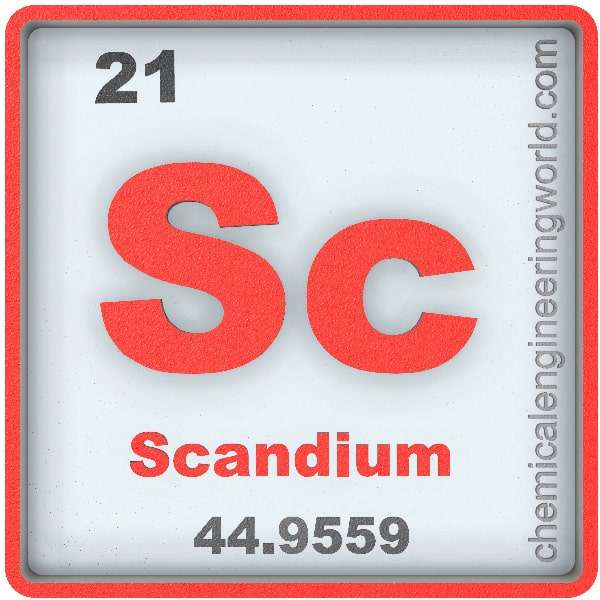Scandium Element Properties and Information

Scandium Element Properties and Information
Scandium is the twenty-first element on the periodic table. Elements are arranged in the periodic table on the basis of the atomic number. Atomic number is the number of protons in the nucleus of the atom. Scandium has an atomic number of 21. It is located in the Group 3 and Period 4 of the periodic table of elements. It is denoted by Sc. The name is derived from the Latin word ‘Scandia’ which means Scandinavia.
Observing the gap between calcium and titanium in the periodic table, Mendeleev predicted in 1869 that an element will be discovered which will be placed between the two elements and he also predicted its oxide. Lars Frederik Nilson extracted several oxides from a complex mineral named euxenite in 1879. He obtained erbium oxide, ytterbium oxide, and also an oxide of an unknown metal. This metal was the Mendeleev’s predicted metal and it was named scandium.
Scandium is a very widely distributed metal because it occurs in minute quantities in over 800 types of mineral species. Scandium is the main constituent of a very rare mineral thortveitite which is found in Scandinavia.
Physical Properties
- Scandium metal is silvery white in colour and it remains so if it is kept unexposed to air.
- The atomic mass of scandium is 44.956
- The melting point of scandium is 1541°C
- The boiling point of scandium is 2836°C
- The density of scandium is 3000 in S.I. units at 20°C
- The isotopes of scandium range from scandium-36 to scandium-60. The only stable isotope is scandium-45.
Chemical Properties
- If scandium is exposed to air it develops an oxide layer and the colouring appears to be slightly yellow or pink.
- Scandium dissolves slowly in most dilute acids.
- When scandium turnings are ignited in air they burn with a brilliant yellow flame.
Methods of Production
Reduction: Most of the scandium obtained from mining is in the form of scandium oxide. Metallic scandium is obtained from scandium oxide using two main steps. First the scandium oxide is converted to scandium fluoride and the second step is reduction, the scandium fluoride is reduced using calcium.
Relevance in Chemical and Related Industries
- Metallurgy: Addition of scandium to aluminium strengthens the aluminium matrix. The addition of scandium to aluminium limits the grain growth in the heat zone of the welded aluminium components. These aluminium-scandium alloys are mostly used by aerospace industries.
- Tracing: Generally scandium-46 is used as a tracing agent in oil refineries.
Relevance in Other Industries
Dentistry: Scandium is one of the components in erbium-chromium-doped yttrium-scandium-gallium garnet lasers. These lasers are used for cavity preparations and also for endodontics.
Health Effects on Exposure
Accumulation: Scandium itself is non-toxic but accumulation of scandium inside the body by long term exposure can damage organs. It can cause lung embolisms and it can become a threat to liver.
Effects on Surroundings
- Accumulation: Dumping of wastes containing scandium compounds in water leads to accumulation of scandium in the water body. This can cause the cell membranes of the aquatic animal to get damaged which negatively affects the sensory nervous system as well as the reproductive system.
References:
































